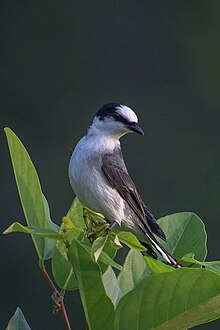| Ashy minivet | |
|---|---|

| |
| Conservation status | |
 Least Concern (IUCN 3.1) | |
| Scientific classification | |
| Domain: | Eukaryota |
| Kingdom: | Animalia |
| Phylum: | Chordata |
| Class: | Aves |
| Order: | Passeriformes |
| Family: | Campephagidae |
| Genus: | Pericrocotus |
| Species: | P. divaricatus |
| Binomial name | |
| Pericrocotus divaricatus (Raffles, 1822) | |
| Synonyms | |
| |
The ashy minivet (Pericrocotus divaricatus) is a passerine bird of eastern Asia belonging to the minivet genus Pericrocotus in the cuckooshrike family Campephagidae. While most of the minivets have shades of yellow, orange and red in their plumage, this species has only greys, whites and blacks. The male is distinctive with a white face and black nape although females can be confused with the female of the brown-rumped minivet. They forage in the canopy, often along with other minivets and join mixed-species foraging flocks.
Description

It is 18.5–20 cm long. The male is grey above and whitish below. It has a black cap with a white forehead and there is a white band across the flight-feathers. The outer tail feathers are white. The bill and feet are black. The female's cap is grey apart from a black band between the bill and eye and a narrow white band above it. The call is a high-pitched, metallic trill. It is considered as closely related to Pericrocotus roseus and Pericrocotus cantonensis but differs in moult pattern. It is one of the few passerine birds that moult their primaries twice in a year and is the longest distance migrant among the minivets.
It breeds in south-east Siberia, north-east China, Korea and Japan. Birds in the Ryūkyū Islands of southern Japan are commonly considered to be a separate species—Ryukyu minivet (P. tegimae). The ashy minivet is a long distance migrant, wintering in South and South-east Asia as far south as Sumatra, Borneo and the Philippines. It is found in forest as well as in more open areas with scattered trees. It forages in the tree canopy for insects sometimes joining mixed-species foraging flocks. Migrant birds can often be seen in large flocks.
The status of the species is considered to be secure and is considered as a "least concern" species by the IUCN. Populations of the species on the Amami Island was found to have increased from 1985–2001.
In the South Asian region, they are considered rare. They were first noted on the Indian mainland only in 1965 although they had been reported in 1897 from the Andaman Islands. It has since been reported with greater regularity.
Four to seven eggs are laid. These are incubated for 17 to 18 days.
Notes
- BirdLife International (2018). "Pericrocotus divaricatus". IUCN Red List of Threatened Species. 2018: e.T22706735A130428286. doi:10.2305/IUCN.UK.2018-2.RLTS.T22706735A130428286.en. Retrieved 12 November 2021.
- Rasmussen PC & JC Anderton (2005). Birds of South Asia: The Ripley Guide. Vol. 2. Smithsonian Institution & Lynx Edicions. p. 325.
- Stresemann, E (1972). "Noch ein Zugvogel mit einer postnuptialen und einer praenuptialen Vollmauser:Pericrocotus divaricatus Raffles". Journal of Ornithology. 113 (2): 218. Bibcode:1972JOrni.113..218S. doi:10.1007/BF01640504. S2CID 7253203.
- Greenberg R, Marra PP (2005). Birds of two worlds: the ecology and evolution of migration. Johns Hopkins University Press. p. 94. ISBN 0-8018-8107-2.
- Stresemann, E. & V Stresemann (1972). "Die postnuptiale und die praenuptiale Vollmauser von Pericrocotus divaricatus Raffles". J. Ornithol. 113 (4): 435–439. Bibcode:1972JOrni.113..435E. doi:10.1007/BF01647606. S2CID 11427932.
- Pittie, A.; A Poddar (2000). "Ashy Minivet Pericrocotus divaricatus (Raffles) in Kanha National Park, Mandla District, Madhya Pradesh". J. Bombay Nat. Hist. Soc. 97 (2): 283.
- Robertson, A (1991). "Occurrence of the Ashy Minivet Pericrocotus divaricatus (Raffles) in Kerala". J. Bombay Nat. Hist. Soc. 88 (3): 455–456.
- Sugimura, Ken; Fumio Yamada & Asako Miyamoto (2003). "Population Trend, Habitat Change and Conservation of the Unique Wildlife Species on Amami Island, Japan" (PDF). Global Environmental Research. 7 (1): 79–89. Archived from the original (PDF) on 2011-07-22.
- ^ Navarro,A (1965). "The Ashy Minivet [Pericrocotus divaricatus (Raffles)]: an addition to the Indian avifauna". J. Bombay Nat. Hist. Soc. 62 (2): 303.
- Santharam,V (1985). "New records - Ashy Minivet and Eyebrowed Thrush in Madras". Newsletter for Birdwatchers. 25 (5&6): 9–11.
- Santharam, V (1988). "Occurrence of the Ashy Minivet (Pericrocotus divaricatus) in Madras city (South India)". J. Bombay Nat. Hist. Soc. 85 (2): 430–431.
- Khacher, Lavkumar (1994). "Ashy Minivet Pericrocotus divaricatus (Raffles) in Himachal Pradesh". J. Bombay Nat. Hist. Soc. 91 (2): 321.
- Santharam, V (1990). "Comments on Ashy Minivets, and on Cormorants in Thekkady". Newsletter for Birdwatchers. 30 (7&8): 9–10.
- Lahkar, B. P.; Ahmed, M. F.; Praveen J.; Singha, H. J. (2006). "First sighting of Black Stork Ciconia nigra and Ashy Minivet Pericrocotus divaricatus from Meghalaya, north-east India". Indian Birds. 2 (6): 169–170.
References
- Brazil, Mark A. (1991) The Birds of Japan, Christopher Helm, London.
- MacKinnon, John & Phillipps, Karen (2000) A Field Guide to the Birds of China, Oxford University Press, Oxford.
- Robson, Craig (2002) A Field Guide to the Birds of South-East Asia. New Holland, London.
External links
| Taxon identifiers | |
|---|---|
| Pericrocotus divaricatus |
|
| Lanius divaricatus | |